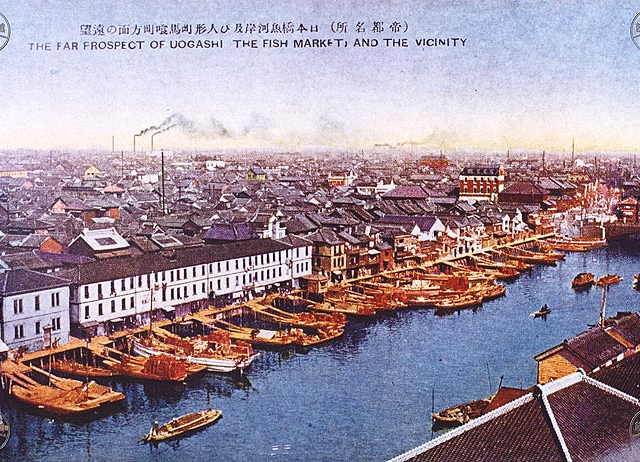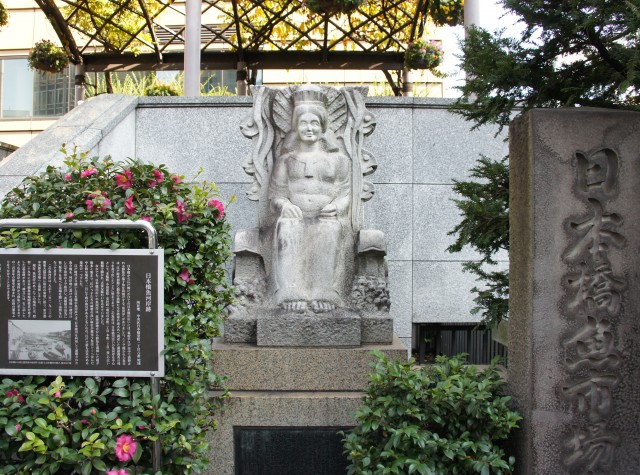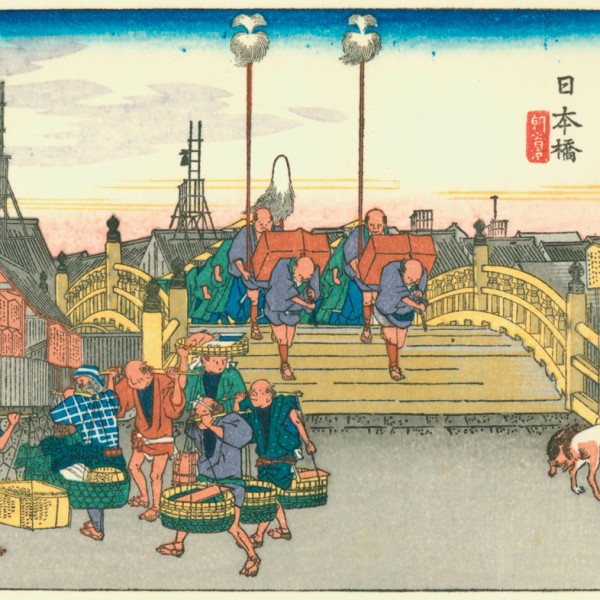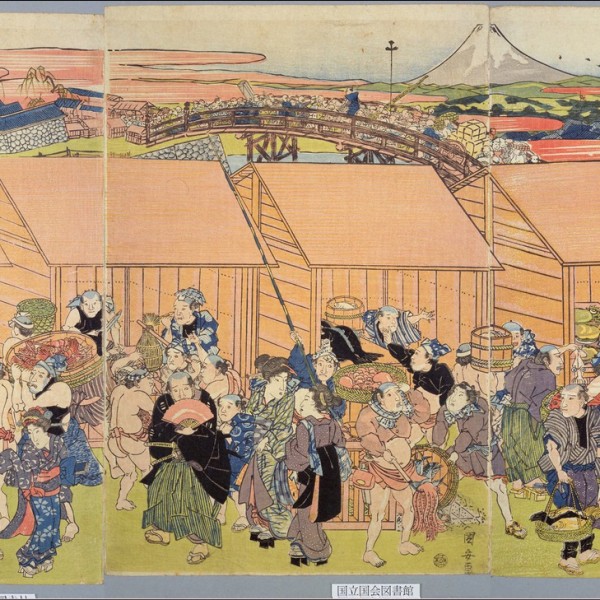- HOME >
- History of Nihombashi >
- The Uogashi - the symbol ・・・

The Uogashi – the symbol of the prosperity of Edo
The Uogashi in the Edo period
The “Uogashi” was the fish market in the Motofunacho / Honodawaracho area (now Nihombashi Honcho 1-Chome and Nihombashi Muromachi 1-Chome) along the north bank of the Nihombashi River between Nihombashi and Edobashi. It was opened at the beginning of the seventeenth century and sustained the diet of the people of Edo and Tokyo for over three hundred years until it was finally transferred to the Tsukiji Market in 1935.
The fish from the seas and rivers of Edo as well as those from Boshu / Kazusa / Shimousa (Chiba Prefecture), Soshu (Kanagawa Prefecture), and Enshu / Zushu (Shizuoka Prefecture) were carried over to the market, filling the bellies of the townspeople and Samurais of Edo.
The first to open a fish market here were the Magoemon Mori family, which moved from Osaka to Edo, and the fishermen who worked for them, under orders by Ieyasu Tokugawa, who founded the Edo Shogunate. It is said that in return for reserving special fish such as sea bream* for the Shogunate and daimyos, they were given permission to trade remaining seafood products within the city. After the Mori Family, Sukegoro Yamatoya, who started his business at the Uogashi, became an influential fish dealer upon loaning fishermen of Sunshu (Shizuoka Prefecture) money for making purchases, building an enclosed spot in the sea for keeping live sea bream, and taking huge orders for live sea bream to be enjoyed by the Shogunate and daimyo families.
*Sea bream has been loved and prized by the people of Japan as a festive fish for ages.
In the early seventeenth century, the population of Edo reached a hundred and fifty thousand people; resulting in a great demand for seafood. By the eighteenth century, the population exceeded a million people with further developments of the Uogashi. According to records from the early eighteenth century, the number of seafood wholesalers, brokers, and distributors reached five hundred people in the four groups of the Motofunacho Group, Honodawaracho Group, Motofunacho Yokodana Group, and Anjincho Group.
It was an honor for a fish dealer to be an official procurer of fish for the Shogunate, but they had to sell their products at much lower prices than market rates and they suffered losses with every sale they made. Even when they sold large portions of the luxury fish, the sea bream, they could receive no more than one-fifth or one-sixth of the market price when they sold to the Shogunate. Their wholesaler colleagues at the Uogashi therefore asked the Shogunate for compensation of the losses. And so, at the beginning of the eighteenth century, they were granted rights to the income generated from the rent paid in eleven areas including Nihombashi, Kanda, Yotsuya, and Akasaka. This resulted in the compensation for the losses.
The scenery of the Uogashi in the early seventeenth century is depicted in the “Edo-zu Byobu” (Folding Screens of the Scenery of Edo) and the scenery of Edo in the early nineteenth century is depicted in the “Edo Meisho Zue” (Guide to Famous Edo Sites), which is a topographical guide to Edo. Various kinds of fish in great quantities were unloaded in the morning and at night, and heavily traded at the storefronts. The boards that display the fish seen in the “Edo Meisho Zue” were known as “itabune”, and many were owned by prominent merchants. There were sales rights to each of these “itabune” boards and there were many small-scale merchants that did business while renting one more at a time. These itabune boards were first set up at riverfront stalls but they began to be used under the eaves of the sheds for storing fish that began to appear on the roads along the rivers as the markets developed. Eventually, they could be seen everywhere at the storefronts from Motofunacho to Honodawaracho.
The Uogashi consisted of areas such as the Yoshiwara red-light district, which was around until 1656, and Sakaicho and Fukiyacho (now the Nihombashi Ningyocho 3-Chome area), where there were Kabuki theaters, along with the busiest part of town in Edo known as “a thousand ryo* a day”, where luxurious homes with entrances of about 1.8 meters and about 36 meters in length cost a thousand ryo.
*The ryo was a unit of currency of during the Edo period. Although it’s value varies depending on the age, a thousand ryo was the equivalent of 130 million yen today.
The prominent wholesalers in the Uogashi used their enormous wealth to sponsor artists in Edo culture such as Kabuki, calligraphic art, woodblock prints, and haiku poetry, and produced many scholars and cultural figures. The person who provided world-famous haiku poet Basho Matsuo with financial aid was his pupil, Sanpu Sugiyama, who was also known as Ichibei Koiya, who was an official procurer of fish for the Shogunate.
The Uogashi continued to gather and provide the people of Tokyo with seafood from across the country even after Japan became a modern nation, but was transferred to Tsukiji due to damages from the Great Kanto Earthquake in 1923. However, the complete transfer took over ten years because of the large number of people who were opposed to it leaving Nihombashi.




